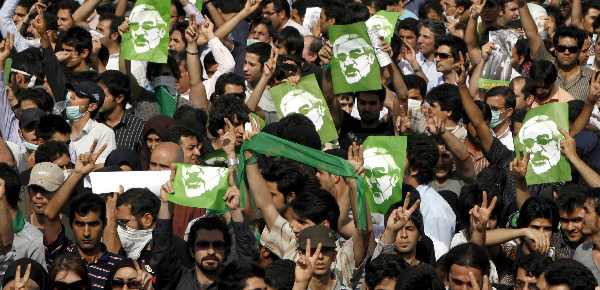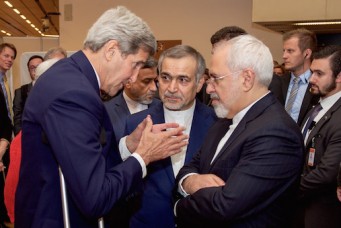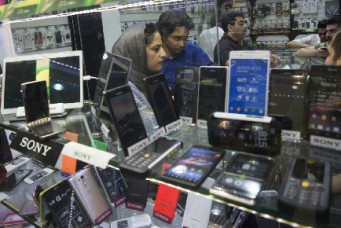How a Nuclear Deal Helps Democracy in Iran
The debate on the Iran nuclear deal has largely ignored the effects that an accord might have on politics and society within the country. An Iranian scholar considers what the future might hold.

Following the June 2009 elections, protesters march in central Tehran, Iran. Abedin Taherkenareh/epa/Corbis
Most of the debate in the West on the Iran nuclear deal has focused on questions related to Western security interests in the Middle East. Will a deal ultimately prevent Iran from obtaining a nuclear weapon? Will it significantly inhibit a nuclear arms race in the region? How will Israel and the Gulf Cooperation Countries be affected, and to what extent will Iran be able to expand its regional influence after the lifting of sanctions? Almost ignored in this discussion, however, are the effects that a nuclear accord might have on internal Iranian politics and society. Specifically, how might a final nuclear agreement between Iran and the West influence the prospects for democracy and democratization within the Islamic Republic?
June 2009 is a key reference point in the struggle for democracy within Iran. Fearing a return of the reformists to power, the Iranian regime falsified the presidential election results that would have removed Mahmoud Ahmadinejad from the presidency. As a result, a nonviolent mini-revolt known as the Green Movement demanded a vote recount, greater political transparency, and more broadly, the democratization of Iran. Protests rocked the country for six months before they were violently suppressed. According to the commander of the Islamic Revolutionary Guard Corps, the Green Movement posed a greater threat to the internal stability of the Islamic Republic than the eight-year Iran-Iraq war.
As a result of this event, Iran’s post-revolutionary social contract lay in tatters. Until this point, Iran’s clerical leaders were able to carefully manage public demands for political change and factional rivalry via an electoral process that though never “free” was perceived to be “fair,” in the sense that the integrity of the ballot box was guaranteed. After the stolen election of 2009 and the ensuing crackdown, this consensus no longer existed. The base of support of the Islamic Republic narrowed considerably as a deep crisis of political legitimacy set in.
Six years have passed, however, since this critical moment in Iran’s post-revolutionary history. While the legacy of the Green Movement continues to haunt the Islamic Republic, in recent years a set of political developments, at the international, regional, and domestic levels, have coalesced to limit the prospects for political change and to bolster authoritarianism in Iran. Collectively, these developments have closed the door for democratization in the short term. If the social and political conditions that produced them were to change, however, these doors to democratization could be reopened.
At the international level, Iran’s dispute with the permanent members of the United Nations Security Council and Germany (P5+1) has negatively affected the prospects for democracy in several ways. The broad sanctions placed on Iran have had a greater impact on ordinary Iranians than they have had on the regime. In particular, civil society and the middle class, which forms the core support base for the democratic opposition, have borne the brunt of Iran’s collapsing economy. Rather than focus on political organizing, a focus on simple survival has taken priority. It is precisely for this reason that some of the most vociferous defenders of a nuclear deal with the West are Iranian civil society and human rights activists.
Secondly, Iran’s ruling oligarchy has successfully deployed a nationalist narrative to justify its nuclear policy internally. Tensions with the West are portrayed through the long history of foreign intervention in Iran. Iranians have been told by their rulers that once again Western powers are bullying Iran, threatening to bomb them, and applying a double standard in attempting to dictate Iran’s internal energy policy. These arguments have resonated across the ideological spectrum. Today many secular Iranians who wouldn’t ordinarily support the Islamic Republic make an exception when comes the nuclear impasse with the West for reasons of national pride.
Thus, by casting itself as the defender of national sovereignty, Iran’s leadership has benefited from the nuclear standoff with the West. After a nuclear agreement, the manipulation of this issue to boost the regime’s legitimacy will be a far more difficult task. This point has been indirectly acknowledged by the editor of Shargh, a leading reformist newspaper, who has noted that if “there’s less tension internationally, there’ll be more stability internally,” implying that a nuclear deal would help create better social conditions for democratization.
A set of regional events has also indirectly bolstered authoritarianism in Iran. The post-Arab Spring regional chaos, marked by sectarianism, the rise of the Islamic State in Iraq and Syria, the spread of Salafi-jihadism, and the collapse of Libya, Syria, Iraq, and now Yemen, have scared Iranians away from demanding political change. As one Iranian blogger has noted, “People now think twice about taking action to change the system because they know change might result in a disaster.”
These regional events have reinforced a preexisting Iranian disdain for violence and revolutionary change. Iranian political culture has been deeply scarred by the upheavals of the 1979 revolution, the bloody Iran-Iraq war, and the post-September 11, 2001, chaos that engulfed neighboring Iraq and Afghanistan in the aftermath of the American occupations. Prominent reformist journalist and Green Movement supporter Saeed Leylaz, who was sentenced to prison after the 2009 events, aptly summarizes how recent regional chaos has reduced demands for political change. Reflecting the new temper among Iranian democrats, he now takes the position that “if we want to emphasize our own points of view over those of our competitors within the system, the result will be another Syria.”
All of this has shaped domestic Iranian politics in negative ways for democratization. In 2015, several trends are now discernible. The first trend is unrelenting state repression. The crackdown that followed Green Movement protests has been ongoing and arguably the level of suppression is greater today than it was in 2009. The hardline-controlled Iranian judiciary continues to hand out heavy sentences to civil society activists; censorship and executions are at record levels; and women and minorities are subject to ongoing harassment, marginalization, and discrimination. In a press conference that coincided with the second anniversary of his election, President Hassan Rouhani admitted that since coming to power there has been “little opening” for advancing his campaign promise to increase social and political freedoms. He blamed rightwing “pressure groups” for this, while reminding his supporters to be patient because “changes cannot take place overnight.”
The second trend pertains to the ongoing and deepening crisis of legitimacy facing the Islamic Republic. This is the Iranian regime’s Achilles’ heel. While foreign crises help direct attention away from it, this dominant feature of Iranian politics fundamentally shapes state-society relations today.
Evidence of this legitimation crisis is abundant. For example, in February, the Iranian judiciary suddenly banned Iranian media from publishing comments by or images of former reformist President Mohammad Khatami. Why a two-time president who occupied the second-highest office in the country for eight years suddenly posed a threat to political order is a revealing question. Part of the answer lies in the fact that as a reformist politician and Green Movement supporter, Khatami remains a popular and influential figure. With parliamentary elections scheduled for 2016, Iran’s clerical elite are starting to panic. There is great fear that the control of the parliament could be lost to reformist parties. In fact, Ali Saeedi, Supreme Leader Ayatollah Ali Khamenei’s special representative to the Iranian Revolutionary Guard Corps, openly acknowledged this fear in a recent speech. Likewise, the head of the powerful Guardian Council, Ahmad Jannati, went a step further and announced that when it comes to the ideological screening of candidates for parliament, “those who have an (ideological) background that is unknown and after investigation this still remains unclear, the Guardian Council does not have the right to approve them.” In other words, there is an assumption that every Iranian citizen is guilty (of regime disloyalty) until proven innocent.
At the level of society, there is irrefutable evidence of Iranians displaying behaviors and pursuing lifestyles that explicitly reject the values and norms of the Islamic Republic. Widespread secularization exists, especially among young people and among the sizable urban and middle classes. This is most visible in terms of avoiding the key Islamic rituals of prayer and fasting. The Ministry of Health recently announced that 150 alcohol treatment centers would be opening in Iran in response to a growing societal epidemic. This is noteworthy because the Islamic Republic officially bans the production, sale, and consumption of alcohol. After the 1979 revolution, there was a major attempt to construct a new Iranian Muslim citizen that rejected Western and secular values. The colossal failure of this project is hard to miss.
Even the supreme leader has publicly acknowledged that the Islamic Republic faces a crisis of legitimacy. During the last presidential election, fearing a low voter turnout, he appealed to Iranians to turn up at the ballot box including those who “for whatever reason [do] not support the regime of the Islamic Republic.” He instead appealed to their sense of (secular) nationalism, arguing that a high voter turnout would send a strong message to Iran’s enemies. In a more recent speech on the anniversary of the death of Ayatollah Khomeini, the supreme leader expressed a fear of liberal values penetrating Iran. He specifically chastised those who were distorting Khomeini’s legacy by claiming he was “liberal-minded, which under no conditions existed in his political, intellectual, and cultural behavior.”
A nuclear deal could help put Iran back on the road to democratization. One of the most controversial aspects of the agreement is the sunset clause. This is the provision that states that for fifteen years Iran will have a limited nuclear program under strict international inspection but after this time period, these restrictions will be lifted. Western critics have pointed to this clause to argue that this “paves Iran’s path to the bomb”—all the country has to do is wait out the clock. Ignored in this debate, however, is that in the coming fifteen years, the Islamic Republic will face increasing challenges from within society that will affect its future political stability and possibly its political trajectory.
The biggest challenge will be the likely death of the supreme leader, who turned 76 last July. Given the enormous power his office wields and the fact there is no senior cleric with sufficient political and religious authority that can replace him, the inevitable departure of Ali Khamenei will produce an enormous internal crisis for the Islamic Republic. When this will happen and how it might play out is unknown, but Khamenei’s passing will create a unique crisis of governance that democratic forces will be able to exploit.
Thus, over the medium term, Iran’s democratic prospects seem brighter. Not only is there a long tradition of democratic activism stretching back to over one hundred years, but the preconditions for democracy that social scientists generally agree upon already exist in Iran. To wit: high levels of socioeconomic modernization (literacy, mass communications, and a modern economy), a suitable class structure (the existence of a sizable middle class), and a proper political culture (norms, habits, and values that are democracy-enhancing). Equally important are the demographic numbers that are favorable to democratization. Specifically, young people now constitute the majority of Iran’s population. They are highly educated, globally connected, politically secular, and deeply alienated from Islamist rule, and what’s more, they desire substantive gradual, nonviolent political change.
A version of this article originally appeared on July 7, 2015.
Nader Hashemi is an associate professor of Middle East and Islamic politics and director of the Center for Middle East Studies in the Josef Korbel School of International Studies at the University of Denver. He is the author of Islam, Secularism, and Liberal Democracy: Toward a Democratic Theory for Muslim Societies, and co-editor of The People Reloaded: The Green Movement and the Struggle for Iran’s Future and, most recently, The Syria Dilemma. On Twitter: @naderalihashemi.




